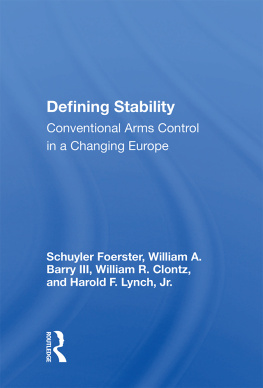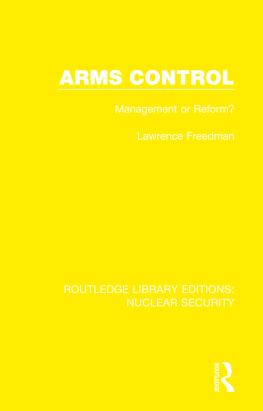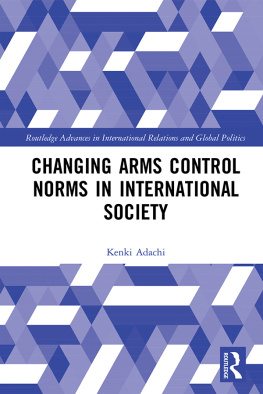First published 1989 by Westview Press, Inc.
Published 2018 by Routledge
52 Vandrbilt Avenue, New York, NY 10017
2 Park Square, Milton Park, Abingdon, Oxon OX14 4RN
Routledge is an imprint of the Taylor & Francis Group, an informa business
Copyright 1989 Taylor & Francis
All rights reserved. No part of this book may be reprinted or reproduced or utilised in any form or by any electronic, mechanical, or other means, now known or hereafter invented, including photocopying and recording, or in any information storage or retrieval system, without permission in writing from the publishers.
Notice:
Product or corporate names may be trademarks or registered trademarks, and are used only for identification and explanation without intent to infringe.
Library of Congress Cataloging-in-Publication Data
Defining stability: conventional arms control in a changing Europe /
Schuyler Foerster... [et al.].
p. cm.
Includes bibliographical references.
ISBN 0-8133-7874-5
1. Arms control. 2. EuropeMilitary relations. 3. Security,
International. I. Foerster, Schuyler.
JX1974.D425 1989
327.1'74'094dc20 89-22505
CIP
ISBN 13: 978-0-367-01356-1 (hbk)
by Robert J. Murray
International relations are changing in fundamental ways. The postwar world is fading. The visionary and successful policies created to help overcome the devastation of war and to cope with the implacable opposition of earlier Soviet leaders have done their job and run their course. New opportunities are before us and new policies and approaches are needed. We are challenged to create for the coming century, with Europe and Japan, an environment in which constructive economic competition can occur within the framework of shared values and a common alliance; and to engage, with Mr. Gorbachev and Co., in the search for better political and economic relations and safer military arrangements. This splendid book addresses the latter challenge.
For nearly a half-century now, the military forces of the Soviet Union and the North Atlantic Treaty Organization have been arrayed against each other along the long front from Stettin in the Baltic to Trieste in the Adriatic, what Winston Churchill called the Iron Curtain. From there, the military confrontation spread to sea, to space, to the various points of political and military dispute around the globe, to the Soviet and American homelands. Nowhere has this military confrontation been more evident than in Central Europe, where since 1945 conventional and nuclear forces of both sides have opposed one another; forces that, over time, have become more numerous, more lethally equipped, and more offensively organized and capable. A complex set of military arrangements has been created there, and skill, wisdomand timewill be needed to unravel them and to create a more stable and less confrontational set of military circumstances. Happily, the new attitudes and policies emanating from the Kremlin are moving us in the right direction to accomplish this task. Some people worry that Mr. Gorbachev may be getting too much credit as peacemaker; but it was the Soviet Union that created the confrontation and the threat to the West, and it is therefore the Soviet Union that must take the initiative in ending the confrontation. The proof of the pudding being in the eating, we will not know for some years who, if anyone, deserves credit; but if all goes well, there will be plenty of credit to share. In the meanwhile, there is the very difficult job at hand to imagine and negotiate safer military arrangements, and it is the aim of the authors of this book to contribute to this work.
The authorsone Air Force and three Army officers, 1988/89 Research Fellows in the National Security Program at Harvard University's John F. Kennedy School of Governmenthave very carefully analyzed the military situation in Europe and the contending views about the military balance and important military variables there. They provide very useful insights into what has often been a confusing debate about the true state of the military situation.
The authors take a large view of arms control objectives. They wisely observe that the aim of arms control policy ought to be not a simple reduction in forces, but the creation of a more stable long-term security situation in Europe. It can, of course, reasonably be argued that the present military situation, despite its high cost and confrontational nature, has achieved considerable stability, that there is now no incentive for war, and that arms control initiatives are as likely to make things worse as better. The evidence for this view is the relatively long period of peace already achieved in Europe and the continuing absence of war on the horizon. The authors, however, suggest that an even more stable set of military circumstances can be created if the military forces of both sides are made less capable of successful surprise attack; if success in war would in future depend upon extensive preparations and a long period of mobilization, and if this process of mobilization, through verification arrangements and other procedures, were made highly visible to the potential defender; and if the defender had the ability to mobilize a stalwart defense in time. The authors suggest various guidelines for policy in pursuing arms control arrangements of this kind. In doing all this, the authors have made a very thoughtful and helpful contribution to understanding this most complex and fundamental set of issues on which our long-term security depends.
The fair East winds now blowing, bringing sunnier skies and pleasant relief, are much to be welcomed. The Soviet Union, with reformists at the helm, is talking and, more modestly, acting in ways that bode well for peace and new relationships. We cannot yet tell, however, whether the blue sky over Moscow is the long-sought break-up of the 70-year-old storm, with consequent possibilities for a new era in international relations, or whether the blue is simply the eye of the storm, soon passing and the storm resuming.
The authors do a nice job of balancing the opportunity for change presented by new Soviet attitudes and the need for a cautious approach to the future. In a world in which storms come and go, and sunny skies do not remain forever, it is wise to keep our powder dry and euphoria in check as we look for ways to make the world a safer, saner place.
Cambridge, Massachusetts
This study reflects our collective interest in strengthening the linkage between strategy, arms control, and military planning in the formulation of defense policy. In a changing political environment, national security threats to the United States take on different forms, as does the character of Alliance relations. Similarly, the long-term prospect for, at best, no-growth defense budgets poses new challenges for defense decision makers who are charged with adapting their institutions to new realities. Despite expectations, the significant increases in defense spending in the first half of this decade did not represent blissful normalcy but were, in fact, an anomaly that is unlikely to be repeated for a long time. Moreover, unprecedented opportunities to pursue significant change in East-West security relationships pose possibilities for constructive change as well as the potential for complacency and self-delusion. Thus, it seems to us especially important that the normally separate worlds of strategy formulation, force planning, and arms control diplomacy form a more integrated whole in facing these challenges.










